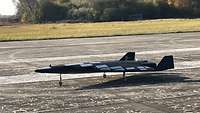“ATHENA” becomes “NOVA” – unmanned spacecraft tested
“ATHENA” becomes “NOVA” – unmanned spacecraft tested
- Date:
- Reading time:
- 2 MIN
In autumn 2022, first flight tests were conducted with the turbojet-powered “ATHENA” demonstrator spacecraft. The remote-controlled spacecraft was constructed by Polaris Raumflugzeuge GmbHGesellschaft mit beschränkter Haftung on behalf of the Bundeswehr. It has a length of 3.5 meters and weighs about 120 kilograms.
Research and technology project offers new opportunities
The underlying research and technology project is being conducted in close collaboration between industry and the Bundeswehr. The focus of the project is on the development of a new type of reconnaissance system. However, the optional use of the spacecraft as a satellite transfer system is also part of the tests. All in all, the project opens up many new opportunities for the Bundeswehr.
The Bundeswehr Technical Center for Aircraft and Aeronautical Equipment in Manching (WTDWehrtechnische Dienststelle 61) plays a specially important role in this research and technology project. Both its “Drone Innovation Hub”, which serves as a link between the Bundeswehr and drone-related start-ups, and the National Center of Expertise for Unmanned Aerial Systems (UASUnmanned Aerial System), established at the agency, are involved in the project.
Safety first
Initial flight tests with demonstrators always involve certain risks. In order to be able to carry out these tests, and to ensure the safety of all parties involved and of the environment, comprehensive coordination efforts were required in advance. Safety is always a top priority.
Therefore, the tests with the demonstrator spacecraft were conducted at the Peenemünde airfield on the island of Usedom in Mecklenburg-Western Pomerania. Its secluded location and its runway – measuring 2.400 meters and extending directly into the Baltic Sea – met all requirements for carrying out these tests. A temporary flight-restricted area was also set up.
Data for the future
The aerodynamic and flight-mechanical findings and data obtained with the help of “ATHENA” are used to further develop the system. The construction of an enlarged model (“NOVA”) is already scheduled for 2023. It is to be equipped with a rocket propulsion system and make supersonic flights possible. Subsequently, the construction of a 1:1-scale prototype is planned.



